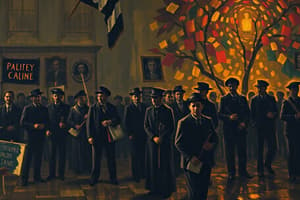Podcast
Questions and Answers
Why is the year 1948 considered a pivotal moment in the history of human rights?
Why is the year 1948 considered a pivotal moment in the history of human rights?
- It marked the end of World War II, leading to a global focus on human dignity.
- It saw the release of the Universal Declaration of Human Rights. (correct)
- It was the year the UN Security Council was formed, giving more power to international law.
- It was when the first international treaty on economic rights was ratified.
Which of the following best describes the role of the UN Secretariat?
Which of the following best describes the role of the UN Secretariat?
- To handle the day-to-day administrative tasks mandated by the General Assembly. (correct)
- To coordinate UN work, research, and policy dialogue.
- To maintain international peace and security by assessing threats of aggression.
- To settle legal disputes between nations according to international law.
How do human rights relate to the concept of social justice?
How do human rights relate to the concept of social justice?
- Social justice is about protecting equal access to rights and opportunities, and caring for the disadvantaged, aligning with human rights. (correct)
- Human rights and social justice are conflicting ideologies with no common ground.
- Human rights ensure that governments can redistribute wealth as they see fit, aligning with social justice goals.
- Social justice only concerns economic equality, while human rights focus on legal and political freedoms.
What is a key distinction between first generation and second generation human rights?
What is a key distinction between first generation and second generation human rights?
In what way do sovereign nations sometimes undermine the pursuit of justice through human rights?
In what way do sovereign nations sometimes undermine the pursuit of justice through human rights?
What is a central challenge related to transnational corporations (TNCs) and human rights?
What is a central challenge related to transnational corporations (TNCs) and human rights?
Which of the following describes what it means for human rights to be 'inalienable'?
Which of the following describes what it means for human rights to be 'inalienable'?
What is the significance of UNDRIP (UN Declaration of Rights of Indigenous Peoples)?
What is the significance of UNDRIP (UN Declaration of Rights of Indigenous Peoples)?
How does the UN Charter (1945) aim to promote international cooperation?
How does the UN Charter (1945) aim to promote international cooperation?
Why are human rights considered 'universal'?
Why are human rights considered 'universal'?
Which of the following is an example of a 'Third Generation Right'?
Which of the following is an example of a 'Third Generation Right'?
Which of the following is most accurate regarding Canada's relationship with UNDRIP?
Which of the following is most accurate regarding Canada's relationship with UNDRIP?
What does it mean for human rights to be 'Interdependent and Indivisible'?
What does it mean for human rights to be 'Interdependent and Indivisible'?
Why does cultural relativism present challenges to the universal application of human rights?
Why does cultural relativism present challenges to the universal application of human rights?
Which organ or body of the UN has the primary function to maintain international peace and security?
Which organ or body of the UN has the primary function to maintain international peace and security?
What is the role of the International Court of Justice?
What is the role of the International Court of Justice?
Which of the following describes the UN's approach to advancing human rights?
Which of the following describes the UN's approach to advancing human rights?
The modern era ushered many rights, which of the following is an example of a right ushered in?
The modern era ushered many rights, which of the following is an example of a right ushered in?
What are the 4 main purposes specified in the UN Charter of 1945?
What are the 4 main purposes specified in the UN Charter of 1945?
What is the correct ordering of how the human right generation is ordered?
What is the correct ordering of how the human right generation is ordered?
Flashcards
Human Rights Structures
Human Rights Structures
Formal structures and processes to monitor, implement, and hold nations accountable for violations.
Definition of Human Rights
Definition of Human Rights
Rights possessed simply by being human, inherent regardless of personal characteristics.
First Generation Rights
First Generation Rights
Civil and political rights, governments must not interfere with these rights.
Second Generation Rights
Second Generation Rights
Signup and view all the flashcards
Third Generation Rights
Third Generation Rights
Signup and view all the flashcards
Fourth Generation Rights
Fourth Generation Rights
Signup and view all the flashcards
Universal Human Rights
Universal Human Rights
Signup and view all the flashcards
Inalienable Human Rights
Inalienable Human Rights
Signup and view all the flashcards
Interdependent Human Rights
Interdependent Human Rights
Signup and view all the flashcards
Modern Era of Human Rights
Modern Era of Human Rights
Signup and view all the flashcards
UN Charter Purpose
UN Charter Purpose
Signup and view all the flashcards
UN General Assembly
UN General Assembly
Signup and view all the flashcards
Security Council Function
Security Council Function
Signup and view all the flashcards
Rights of Indigenous Peoples
Rights of Indigenous Peoples
Signup and view all the flashcards
What does UNDRIP do?
What does UNDRIP do?
Signup and view all the flashcards
Indigenous Treaty Obligations
Indigenous Treaty Obligations
Signup and view all the flashcards
Transnational Corporations
Transnational Corporations
Signup and view all the flashcards
Social Justice Dimensions
Social Justice Dimensions
Signup and view all the flashcards
Pursue formal justice.
Pursue formal justice.
Signup and view all the flashcards
Study Notes
Introduction to Human Rights
- Human rights include structures and processes to monitor, implement, and hold nations accountable for violations.
- Nations undermine justice when they abuse power and control, failing to correct inequality.
- Human rights involve legal obligations and addressing injustices through social movements.
Human Rights Overview
- Human rights fundamentally concern the relationship between nations and their citizens.
- A human right is inherent to all humans regardless of personal characteristics.
- Human rights are legally recognized for every human, without discrimination based on ethnicity, culture, religion, gender, age, handicap, or circumstance.
Types of Human Rights
- First Generation Rights are civil and political rights including liberty rights; governments must not interfere with these rights.
- Included under First Generation Rights are security, equality before the law, freedom of movement, thought, conscience, opinion, expression, assembly, association, and participation.
- Second Generation Rights focus on economic, social, and cultural aspects, ensure adequate living standards, education, cultural life, health, social security, and the right to work in favorable conditions.
- Governments must actively provide programs and services under Second Generation Rights.
- Third Generation Rights address poverty and famine and promote group solidarity and collective rights with a mix of positive and negative rights.
- Included under Third Generation rights are the right to peace, humanitarian relief, sustainable development, social development, and cultural self-determination.
- Fourth Generation Rights focus on non-human life forms and bioethical issues, referred to as New Frontier rights.
- Included under Fourth Generation rights are endangered species, humane treatment of animals, fetus rights, right to choose to end one's life with assistance, and rights of rivers, lakes, and oceans).
Essential Human Rights Principles
- Human rights are universal, extended to all regardless of location.
- Human rights are inalienable, only removed by due process in specific cases.
- Human rights are interdependent and indivisible; improvement or degradation of one right affects others.
- Equality and non-discrimination are included in human rights treaties and international law.
- Entitlement to human rights implies an obligation to respect the rights of others.
Brief History of Human Rights
- Historically, land ownership or aristocracy conferred rights; few others had rights.
- The modern era (1900-present) introduced economic, social, cultural, and collective rights, with global spread.
- The year 1948 marked the release of the Universal Declaration of Human Rights.
United Nations - Overview
- The UN Charter of 1945 outlines four main purposes: maintaining peace and security, developing friendly relations among nations, fostering social and economic cooperation across countries, and harmonizing actions of nations.
United Nations Overview - Continued
- The UN includes five main organs: the General Assembly, Economic and Social Council, Security Council, International Court of Justice, and UN Secretariat.
- The General Assembly is the a UN body with universal representation, where each country has one vote and where treaties are adopted.
- The Economic and Social Council coordinates work, research, policy, and dialogue through recommendations to 54 members and nine committees that monitor treaty implementation.
- The Security Council maintains international peace and security by assessing threats and recommending settlement options.
- The International Court of Justice settles legal disputes and provides advisory opinions on legal matters.
- The UN Secretariat handles administrative work mandated by the General Assembly.
- The UN has humanitarian and military intervention roles when atrocities like genocide occur.
- Unilateral interventions occur when one country forcibly enters another based on humanitarian grounds.
- Engaged representatives monitor, measure, and ensure compliance involving engagement, research, and reporting and presentation from non-governmental organizations.
- The UN has a non-adversarial approach with a weak monitoring ability, opting for public shaming to advance human rights.
Rights of Indigenous People in Canada
- The UN Declaration of Rights of Indigenous Peoples (UNDRIP) was passed in 2007 after 25 years of activism.
- UNDRIP is regarded as a validation of colonialism and oppression, aiming to empower Indigenous Peoples.
- Canada initially voted against UNDRIP but became a supporter in 2016, requiring measurement, reporting, and compliance with its principles.
UNDRIP
- UNDRIP protects Indigenous peoples' collective rights without overriding existing agreements.
- UNDRIP comprises 45 articles including foundational rights, self-governance, life and security, culture, education, information, participation, development, economic and social rights, country rights, resources, and traditional knowledge.
- UNDRIP is referenced in the Truth and Reconciliation Calls to Action #43 and #44.
Issues and Debates related to Human Rights
- A country's failure to meet Indigenous Treaty obligations is a barrier to human rights.
- There is the belief that sovereign nations should have ultimate power over their citizens.
- Cultural relativism opposes formal justice due to unequal treatment across nations.
- Some nations use Human Rights to advance political agendas, using it as a tool to invade sovereign nations.
- Transnational corporations benefit from open borders, establishing factories and extracting resources.
- TNCs sometimes violate workplace standards and infringe upon environmental rights.
- TNCs are not obligated to follow international legal principles.
- Sovereign states are responsible for protecting human rights from abuse.
Human Rights in Relation to Social Justice - Dimensions
- Social justice protects equal access to rights and looks after the least advantaged.
- Four dimensions relate social justice and human rights: Equitable distribution, recognition of dignity, important participation, and capacity development.
Conclusion
- Human rights in international treaties are the means to pursue formal justice.
- Although these treaties are not legally binding, the UN monitors, measures, and holds nations accountable for abuses.
Studying That Suits You
Use AI to generate personalized quizzes and flashcards to suit your learning preferences.




